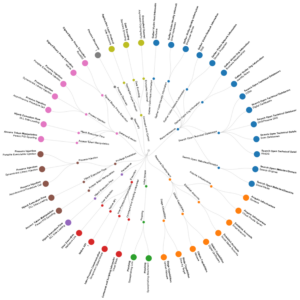An effective incident response (IR) process is key to safeguarding your business against cyberattacks, data breaches and other security incidents. When selecting your response strategy between two main processes – NIST four-step and SANS six-step processes -it is vitally important that it meets all requirements set out by each.
Utilize advanced threat protection tools, including deception technology and ransomware protection solutions, to guard against attacks that bypass antivirus software, endpoint detection solutions, and other cybersecurity solutions. These include deception technology and ransomware protection features.
Network Detection and Response (NDR)
Gartner has identified network detection and response (NDR) as one of three pillars for the SOC visibility triad, alongside endpoint detection and response (EDR) and security information and event management (SIEM). NDR solutions assist organizations by monitoring network traffic, searching for suspicious behavior, and discovering all devices within an organization.
NDR solutions use advanced traffic analysis to track north-south and east-west traffic across an organization’s internal network as well as its perimeter, to detect threat activities, such as lateral movement that is characteristic of advanced threats and insiders; it also aids in uncovering any malicious activity hiding within encrypted traffic.
NDR stands apart from traditional detection-focused security tools in that it can observe every event an attacker executes on a network, from reconnaissance activity used to target hosts and collect sensitive data to command-and-control and discovery activities that may only happen once an attack has started. This provides greater accuracy for detection while simultaneously speeding up incident investigation and response.
NDR solutions can automatically prioritize and raise alerts so they can be immediately addressed by the SOC team while also activating other security tools to take immediate or automated actions, such as terminating suspicious network connections or terminating them manually. This can help disrupt an attack while it occurs and significantly decrease dwell times – typically five-seven months, as documented in post-attack investigation surveys.
Endpoint Detection and Response (EDR)
EDR provides continuous endpoint monitoring and detection capabilities, allowing security professionals to detect attacks that evade traditional security tools. Collecting large volumes of endpoint data, such as process activity, driver loading, memory access and disk access, and network connections, helps security professionals detect covert threats more quickly. Its tracking feature helps teams visualize potential attackers to anticipate better and counter their tactics and techniques.
Traditional systems typically rely on signatures to detect potential threats, yet hackers constantly adapt their methods to bypass detection. EDR solutions employ machine learning-powered detection techniques to monitor abnormal activity and alert when suspicious activity is detected.
EDR allows organizations to detect and investigate attacks faster while decreasing the risk of data breaches or other cybersecurity incidents. At its core, contextual telemetry combines endpoint visibility and logging data, threat intelligence integrations, and automated response capabilities into one comprehensive solution that enables rapid investigation and remediation.
EDR solutions can reimage or roll back an infected endpoint to its pre-infection state and restore trust within an environment by eliminating compromised credentials and devices. All this is enabled through a consolidated user interface that reduces entry barriers while helping security analysts perform their jobs more efficiently.
Extended Detection and Response (XDR)
An XDR solution works alongside existing security tools to collect and analyze deep activity data from endpoints, networks, servers, and cloud workloads. It ingests large volumes of information before normalizing it before applying machine learning algorithms to detect threat patterns – helping analysts to focus on real threats instead of false positives or other irrelevant anomalies.
Automatic alert prioritization based on their significance is also provided, providing analysts with rich context that helps quickly pinpoint an attacker’s source, speeding response time and mitigating damage to your organization. Furthermore, unlike traditional SIEM solutions that serve solely as detection tools, true XDR solutions enable organizations to respond to and remediate automated threats throughout their lifecycle.
Security teams can easily control an entire platform from a central console, eliminating the need to log into numerous systems and dashboards – streamlining processes while freeing up resources for other projects.
An XDR solution provides comprehensive threat visibility by working across layers, collecting and correlating data from email, endpoints, networks, servers, cloud workloads, and workloads. It provides granular visibility that detects advanced attacks such as insider misuse, external attacks and ransomware; you can stop threats at every stage of their kill chain with features like incident views, root cause analysis and prioritizing alerts with attack scoring to mitigate threats at every stage.
Incident Response
Incident response (IR), or digital forensics or incident handling, is an activity designed to deal with actual cyberattacks and data breaches. This involves detecting an attack, taking control of the situation and mitigating potential damages while decreasing recovery times and costs.
- Preparation – The preparation phase involves creating procedures, setting rules of engagement, and identifying key players for incidents to occur. The goal of this stage is to avoid disaster by having an actionable plan ready in case any form of incident arises.
- Detection – In this phase, alerts activated by suspicious behavior and a process for identifying and classifying threats are sent out. A strong threat intelligence infrastructure that can identify advanced attacks immediately and protect organizations against them is vital.
- Respond – The response phase involves stopping the spread of an attack, eliminating malware and compromised user accounts, and restoring systems to normal operations. In addition, this stage provides an opportunity to learn lessons from past incidents while strengthening security measures to avoid similar attacks in the future.
Implement a scalable and automated response system as the final step. This might involve integrating security tools with security orchestration, automation and response (SOAR). SOAR platforms use data collected by these tools to trigger workflows and tasks based on defined thresholds automatically; additionally, they can automate low-level tasks historically performed manually by human analysts and remediate lower-risk vulnerabilities.
